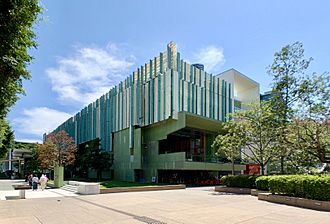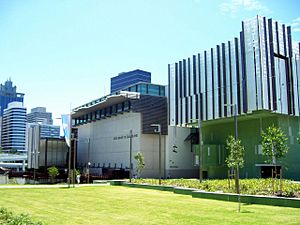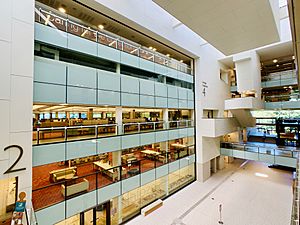State Library of Queensland facts for kids
Quick facts for kids State Library of Queensland |
|
|---|---|

Exterior of State Library
|
|
| Former names | The Brisbane Public Library The Public Library of Queensland |
| Alternative names | SLQ |
| General information | |
| Type | Public Building |
| Location | Kurilpa Point, South Bank, Brisbane |
| Address | Cultural Precinct, Stanley Place, South Bank, South Brisbane, Queensland |
| Coordinates | 27°28′16″S 153°01′06″E / 27.471087°S 153.018281°E |
| Construction started | 2004 |
| Completed | 2006 |
| Inaugurated | 25 November 2006 |
| Technical details | |
| Floor count | 5 |
| Floor area | 28000m2 |
| Design and construction | |
| Architecture firm | Donovan Hill, Peddle Thorp |
| Awards and prizes | RAIA Sir Zelman Cowen Award for Public Architecture, 2007 RAIA Emil Sodersten Award for Interior Architecture, 2007 |
The State Library of Queensland is the main reference and research library provided to the people of the State of Queensland, Australia, by the state government. Its legislative basis is provided by the Queensland Libraries Act 1988. It contains a significant portion of Queensland's documentary heritage, major reference and research collections, and is an advocate of and partner with public libraries across Queensland. The library is at Kurilpa Point, within the Queensland Cultural Centre on the Brisbane River at South Bank.
Contents
History
The Brisbane Public Library was established by the government of the Colony of Queensland in 1896, and was renamed the Public Library of Queensland in 1898. The library was opened to the public in 1902.
In 1934, the Oxley Memorial Library (now the John Oxley Library), named for the explorer John Oxley, opened as a centre for research and study relating specifically to Queensland. The Libraries Act of 1943 established the Library Board of Queensland to manage the Public Library of Queensland; three years later, under the terms of The Oxley Memorial Library of Queensland Act, it took over management of the Oxley Memorial Library as well.
In March 1947, James L. Stapleton was appointed Queensland's first State Librarian. Stapleton advocated for a new building for the library and that library services should be free to the public. He remains the longest-serving CEO, and has been followed by five others: Sydney Lawrence (Lawrie) Ryan from 1970 to 1988, Des Stephens from 1988 to 2001, Lea Giles-Peters (the first woman to be appointed to the position) from 2001 to 2011, Janette Wright, from 2012-2015 and from 2016, Vicki McDonald.
In 1971, the "Public Library" became the "State Library." The following year, the Public Library Service was established to liaise with Queensland local authorities regarding their public libraries; a subsidy for employing qualified staff in public libraries was also established. A few years later the Country Lending Service was established to provide book exchange and other services to public libraries in Queensland's smaller local government areas. Under the new name of Rural Libraries Queensland, the service is still going strong today, administered by the State Library's Public and Indigenous Library Services program.
In 2003, the State Library began a new mission of establishing Indigenous Knowledge Centres (IKCs) in the Cape York and Torres Strait areas. There is now a network of 22 IKCs in remote and regional communities: across Cape York, the islands of the Torres Strait, Central Queensland and at Cherbourg in South East Queensland.
The State Library's current strategic vision is to enrich the lives of Queenslanders through creatively engaging people with information, knowledge and community.
In early 2011, the library donated 50,000 pictures to Wikimedia Commons.
Collection and services
The library holds general collections, including books, journals and magazines, newspapers, audiovisual items, family history, maps, music, ephemera, Internet and electronic resources. There are research collections and services – including the John Oxley Library and the Australian Library of Art, which includes the James Hardie Library of Australian Fine Arts.
The library is home to two UNESCO Memory of the World significant collections, Labour Party Manifesto and the Margaret Lawrie collection of Torres Strait Islands material.
The library holds a collection of Queensland election-related material, including websites, posters, flyers and how-to-vote cards. It also holds the Frank and Eunice Corley House Photographs Collection, which contained more than 60,000 photographs of Brisbane suburbia.
Services
- Access to collections, including access to 50,000 Copyright-free Queensland images through Wikimedia Commons
- Provides books and other resource material to public libraries throughout Queensland.
- Specialist services to public libraries in a number of areas, including services to young people and multicultural communities.
- Public programs and exhibitions, including exhibition loans to schools, museums and other community organisations.
- Outreach programs in reference, research, information literacy, Internet training and digitisation throughout Queensland for public library staff and the general community.
- Library services to Aboriginal people and Torres Strait Islanders including the establishment of Indigenous Knowledge Centres primarily in Cape York and Torres Strait regions and increasing the employment and training opportunities for Indigenous peoples in the library industry.
- A digital culture centre called The Edge, for young people.
- A free coworking space, the Business Studio, supports startups, entrepreneurs and small business.
Exhibitions
The library has hosted a number of prominent exhibitions, including
Tours
Free guided tours of the building are available. In 2010, a total of 3730 school students participated in a tour.
Rural Libraries Queensland
Rural Libraries Queensland (formerly the Country Library Service) is a collaboration between the State Library of Queensland and approximately 30 of the local government councils to provide library libraries to rural communities.
National edeposit (NED)
As a member library of National and State Libraries Australia, the organisation collaborated on the creation of the National edeposit (NED) system, which enables publishers from all over Australia to upload electronic publications as per the 2016 amendment to the Copyright Act 1968 and other regional legislation relating to legal deposit, and makes these publications publicly accessible online (depending on access conditions) from anywhere via Trove.
Architecture
The Brisbane Public Library moved into the Old State Library Building in William Street, Brisbane in 1899. This building had formerly been occupied by the Queensland Museum.
The Library originally shared accommodation in the building with an art gallery. In the late 1950s, an extension, with a distinctive tiled mural on the exterior, was built onto the building to provide more space. The mural was the winning design in a national competition held in 1958.
In 1988, the State Library of Queensland moved to a new home within the Queensland Cultural Centre at South Bank, near the Queensland Museum and the original Queensland Art Gallery.
In 2004, work began on the Millennium Library Project - a major redevelopment of the existing State Library building. After three years of extensive redevelopment, the South Bank building officially re-opened on 25 November 2006 as "a new cultural and knowledge destination" and a fitting showcase for the collections. New services include the kuril dhagun Indigenous Knowledge Centre, and The Corner, an activities area for children under 8, their parents, carers, educators and friends.
The newly-redeveloped building was designed by Brisbane-based architecture firms Donovan Hill and Peddle Thorp. Their work earned them the prestigious RAIA Sir Zelman Cowen Award for Public Architecture, 2007 (award for best public building in Australia), the RAIA Emil Sodersten Award for Interior Architecture, 2007, the RAIA Queensland Architecture Award for Brisbane Building of the Year 2007, the RAIA FDG Stanley Award for Public Buildings Architecture 2007 and the AIB Queensland Awards - Project of the Year + Sustainability Commendation 2007.
The building overlooks Stanley Place between the Queensland Art Gallery and the new Queensland Gallery of Modern Art.
Governance
The State Library of Queensland is governed by the Library Board of Queensland and comprises the following program units:
Content Development
- Queensland Memory
- Discovery
- Information Communications and Technology Services
Regional Access and Public Libraries
- Literacy and Young People
- Public Library Development
- Regional Partnerships
- SLQ Cairns
Engagement and Partnerships
- Indigenous Services
- Visitor Experience
- Learning and Participation
- The Edge
- Asia Pacific Design Library
- Business Studio
- Government Research and Information Library
Corporate Services
- Finance, Facilities & Administration
- HR Consultancy
- Strategic Reporting
- People and Planning
Office of the State Librarian
- Communications
- Queensland Library Foundation
Queensland Business Leaders Hall of Fame
In 2009 State Library of Queensland, the Queensland Library Foundation and QUT Business School at Queensland University of Technology collaborated to establish the Queensland Business Leaders Hall of Fame initiative. The QBLHOF recognises outstanding contributions made by organisations, companies and individuals to develop the Queensland economy and society, both contemporary and historical. A governing committee determines a list of inductees based on a set of criteria including:
- Sustained leadership
- Major financial contribution
- Pioneering
- Outstanding contribution
- Achievement of iconic status
The inductees are announced each year in July at a gala event. Since 2014 the QBLHOF has also awarded an annual Fellowship, to recipients working on a research project that utilises the resources of the John Oxley Library to produce new interpretations of Queensland's business history.




